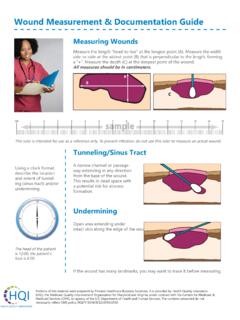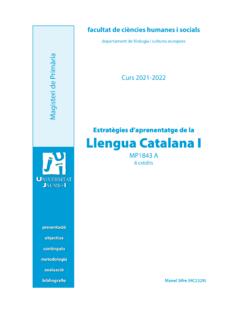Transcription of Wound Measurement & Documentation Guide final092112
1 Wound Measurement & Documentation GuidePortions of this material were prepared by Primaris Healthcare Business Solutions. It is provided by Health Quality Innovators (HQI), the Medicare Quality Improvement Organization for Maryland and Virginia, under contract with the Centers for Medicare & Medicaid Services (CMS), an agency of the Department of Health and Human Services. The contents presented do not necessarily reflect CMS policy. HQI/11 SOW/8/22/2016/2556 Measuring WoundsMeasure the length "head-to-toe" at the longest point (A). Measure the width side-to-side at the widest point (B) that is perpendicular to the length, forming a "+". Measure the depth (C) at the deepest point of the Wound . All measures should be in centimeters. ABCsampleCM123487651312111091514 This ruler is intended for use as a reference only. To prevent infection, do not use this ruler to measure an actual a clock format, describe the location and extent of tunnel-ing (sinus tract) and/or head of the patient is 12:00, the patient's foot is 6 the Wound has many landmarks, you may want to trace it before TractA narrow channel or passage-way extending in any direction from the base of the Wound .
2 This results in dead space with a potential risk for abscess area extending under intact skin along the edge of the Measurement & Documentation GuideWound Location: Designate left, right, top, bottom, side, front, middle, etc., as appropriate(for example, inner left knee) Describe anatomical location according to your facility practice; abdomen,knee, coccyx, sacrum, trochanter (hip), ischial tuberosity (buttock), calca-neus (heel), malleolus (ankle), specific! Location description should direct staff to exact area for : I, II, III, IV, suspected deep tissue injury (sDTI), unstageablePressure Ulcer DocumentationSize: L x W x D Length (head-to-toe) Width (hip-to-hip) Depth (deepest point)Exudate/Drainage: Amount None, dry, scant, moist, small, medium,large, copiousColor Serous (thin, watery, clear) Sanguineous (thin, bright red) Serosanguineous (thin, watery, pale red topink) Purulent (thick or thin, opaque to tan toyellow or green)Odor None, foul, pungent, fecal, musty, sweet Wound Edges: Border shape; irregular, round, oblong,etc.
3 Edges attached/unattached; undermining Rolled under (epibole) CallusedWound Base: Granulation (beefy red, bubbly inappearance) Epithelialization (light to deep pink, pearlylight pink; may form islands in the woundbed) Necrotic Tissue Slough - thin stringy consistency;yellow, gray, white, green, brown Eschar - thick hard consistency;brown to black Adherency - Non-adherent, looselyadherent, firmly adherent Tunneling/Sinus Tract (use clock todesignate location) Undermining (use clock to designatelocation)Surrounding Tissue: Color (red, pink, pallor, purple, normalskin tones) Edema; pitting, non-pitting Firmness Temperature Tissue Characteristics: intact, macerated,rash, excoriated, Assessment: Rate on scale of 1-10 before, during andafter treatment; episodic or chronic Interventions for painWound Progress: Improving, deteriorating, no change Interventions in place; pillows, low airloss beds, special devices, nutritionalsupplements, etc.
4 Continued treatment or notify MD andresponsible party of need for chang




